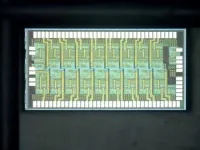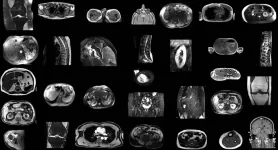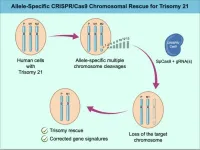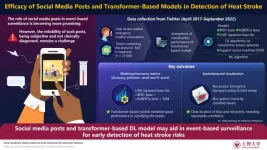(Press-News.org) An innovative circuit design could enable miniature devices, such as microdrones and other microrobotics, to be powered for longer periods of time while staying lightweight and compact. Researchers from the University of California San Diego and CEA-Leti developed a novel self-sustaining circuit configuration—featuring miniaturized solid-state batteries—that combines high energy density with an ultra lightweight design.
The results will be presented at the 2025 IEEE International Solid-State Circuits Conference (ISSCC), which will take place from Feb. 16 to 20 in San Francisco.
One important application envisioned for microdrones is how they could assist first responders in disaster cases. When a building collapses, for example, current robots might be too large to maneuver in the resulting confined areas. Yet, a swarm of tiny wing-flapping drones—so tiny that one can rest on a fingernail—could enter the tight spaces to inspect the building for chemical hazards or even to search for trapped people.
The design dilemma, however, is that these devices need lasting power to fly around long enough. But because they are so small (tens of grams or ideally less), carrying a large battery is impractical. As a result, current microdrones can only fly for a few minutes.
“In order to maximize the flight time, you need to minimize the weight of all the components of the system, and that includes the battery and all electronics needed to process power,” said Patrick Mercier, a professor in the Department of Electrical and Computer Engineering at the UC San Diego Jacobs School of Engineering and co-senior author of the paper. “It’s a very difficult and delicate trade-off.”
Slice and dice
To move around, most microrobots use piezoelectric microactuators, which translate an electrical signal to a precisely controlled physical movement. However, these microactuators need high voltages to work—as much as tens to hundreds of volts—while today’s lithium-ion batteries supply only 4 volts. Boosting the voltage typically requires bulky inductors or capacitors, which add significant weight and volume, making them suboptimal for such small devices.
Consequently, Mercier and his team, including the study’s co-first author Zixiao Lin, an electrical and computer engineering Ph.D. student at UC San Diego, turned away from conventional small batteries to something more compact and lightweight. “The breakthrough in our approach comes from utilizing emerging solid-state batteries, which possess the unique capability to scale down without sacrificing energy density,” said Gaël Pillonnet, scientific director of CEA-Leti’s Silicon Component Division and co-senior author of the paper.
“Instead of having one larger battery, we could take that exact same battery and slice and dice it up into 10 or 20 or more individual batteries,” said Mercier. And each of those individual batteries will have the same energy density as the larger parent battery.
Then, with those sliced-up batteries, the team built a driving circuit with a so-called flying battery configuration. Unlike conventional battery setups, which are typically fixed in one arrangement, the flying battery offers versatility. It allows the system to dynamically switch how individual battery units are connected, adapting in real time to the system's shifting energy needs.
Here, the batteries can either be connected in series (where the voltages of individual batteries add up) or in parallel (where the total energy capacity increases but the voltage stays the same). For example, when the drone needs higher voltage to operate its microactuator, the system dynamically connects individual batteries in series, stacking them step by step, until the required voltage is reached. And when less power is needed, the batteries can be rearranged in parallel to maximize energy storage efficiency.
This switching between series and parallel configurations happens in tens of milliseconds, all without the weight of additional passive components.
Charge and recharge
The system takes efficiency a step further by incorporating energy recovery. This is made possible in part due to the rechargeable nature of the solid-state batteries and the ability of the microactuator to function as a capacitor. The microactuator gets charged up to a high voltage to actuate, then discharges that energy back into the batteries recharging them via a step-by-step destacking process. As in the charging stage, it recharges adiabatically—that is, without the transfer of heat—in the most efficient way possible.
Mercier likens it to how regenerative braking works in a hybrid or electric vehicle. “We can drive the microactuator extremely efficiently and recover some of the energy that we deliver to it, such that the battery continues to last even longer,” he said.
Using 18 battery units of an early commercially available solid-state battery, the system generated up to 56.1 volts while operating continuously for 50+ hours. The entire system weighed just 1.8 grams.
The team achieved even better results with tinier solid-state batteries that were custom developed at CEA-Leti to have higher energy density. Using these batteries, the system’s weight dropped to a mere 14 milligrams. “Our results demonstrate that the concept is scalable to different target frequencies or voltages beyond the initial proof of concept,” said Pillonnet.
The next step will be to test the drive system in an actual microrobot. Beyond that, the team will continue to optimize the solid-state batteries and push for even higher voltage outputs.
Paper: “An Autonomous and Lightweight Microactuator Driving System Using Flying Solid-State Batteries.” Co-authors include Zixiao Lin* and Patrick Mercier, UC San Diego; and Jim Wouda*, Sami Oukassi, and Gaël Pillonnet, CEA-Leti, France.
*These authors contributed equally
END
New microactuator driving system could give microdrones a jump-start
2025-02-18
ELSE PRESS RELEASES FROM THIS DATE:
Racial disparities seen in same-day breast diagnostic and biopsy services
2025-02-18
OAK BROOK, Ill. – Different sociodemographic groups, especially racial and ethnic minorities, are less likely to receive timely breast cancer diagnostic services after an abnormal screening mammogram, according to a study published today in Radiology, a journal of the Radiological Society of North America (RSNA).
Routine yearly screening mammography is an important first step in the early diagnosis of breast cancer. When a screening mammogram comes back as abnormal, additional imaging and image-guided biopsy may be necessary to diagnose breast cancer.
When it is caught early enough, before symptoms are present, breast cancer can be easier to treat and significantly ...
Researchers develop AI model to automatically segment MRI images
2025-02-18
OAK BROOK, Ill. – Research scientists in Switzerland have developed and tested a robust AI model that automatically segments major anatomic structures in MRI images, independent of sequence, according to a new study published today in Radiology, a journal of the Radiological Society of North America (RSNA). In the study, the model outperformed other publicly available tools.
MRI provides detailed images of the human body and is essential for diagnosing various medical conditions, from neurological disorders to musculoskeletal injuries. For in-depth interpretation of MRI images, the organs, muscles and bones in the images are outlined ...
Racial disparities seen in care after abnormal mammograms
2025-02-18
Despite similar availability of diagnostic technologies to women of different racial and ethnic groups, significant disparities were seen in who actually received same-day diagnostic services and biopsies after abnormal mammogram findings, new research shows. Even when breast-care facilities had the necessary technology and capabilities, minority groups were less likely than white women to receive diagnostic imaging on the same day as an abnormal screening result. Black women in particular were less likely to receive same-day biopsies, compared with white women.
The findings of a retrospective study are to be published ...
New research brings hope for improved outcomes and survival rates for patients facing a pancreatic cancer diagnosis
2025-02-18
New research brings hope for improved outcomes and survival rates for patients facing a pancreatic cancer diagnosis
The discovery of a 'biomarker panel' could have a profound impact on the ability to identify patients at risk of developing PC at an earlier stage
Pancreatic cancer (PC) is the worst prognosis cancer globally, with just 13% of patients who are diagnosed with PC surviving for 5 years or more after initial diagnosis. In Ireland, there are approximately 900 cases of PC per year, and 820 PC-related deaths. Early detection of PC is the primary concern of most PC research, as it has the potential to make a substantial difference to the treatment and survival of patients.
Survival ...
Using CRISPR to remove extra chromosomes in Down syndrome
2025-02-18
Gene editing techniques may eventually allow trisomy to be treated at the cellular level, according to an in vitro proof-of-concept study. Down syndrome is caused by the presence of a third copy of the 21st chromosome. The condition occurs in approximately 1 in 700 live births and is relatively easy to diagnose at early stages of development. However, there are no treatments. Ryotaro Hashizume and colleagues use the CRISPR-Cas9 gene editing system to cleave the third chromosome in previously generated trisomy 21 cell lines derived from both pluripotent cells and skin fibroblasts. The technique is able to identify which chromosome has been duplicated, ...
Social media posts and transformer-based models for early detection of heat stroke
2025-02-18
Heat stroke poses a significant health risk, especially during extreme temperature conditions. As global temperatures rise due to climate change, the frequency and severity of heatwaves have increased, putting vulnerable populations at greater risk. This shift underscores the need for effective, real-time methods for early detection and response to heat stroke risks, ensuring timely intervention and reduced impact of these rising threats. While previous studies have highlighted the potential of social media posts, such as tweets, to offer real-time insights into various events, its application in detecting heat stroke risks ...
Restoring grasslands led to fewer human-wildlife conflicts in Kenya, research finds
2025-02-18
ARLINGTON, Va. (Feb. 18 2025) – A new study led by Conservation International scientists and published today has found that grassland restoration can reduce human-wildlife conflict and social conflicts in communities facing resource scarcity.
Grasslands, vital ecosystems for livelihoods and biodiversity, are under increasing pressure from climate change and human activity. The Chyulu Hills region of Kenya exemplifies these challenges, as it is home to iconic wildlife such as African elephants and black rhinos, which share the land with pastoral Maasai communities. This coexistence often leads to competition over limited water, land and pasture, sparking ...
What makes us remember our dreams?
2025-02-18
Some people wake up vividly recalling their dreams from the night, and can tell precise stories experienced during the night, while others struggle to remember even a single detail. Why does this happen? A new study, conducted by researchers at the IMT School for Advanced Studies Lucca, and published on Communications Psychology explores the factors that influence so called "dream recall"— the ability to remember dreams upon awakening—and uncovers which individual traits and sleep patterns shape this phenomenon.
The reason why there is such a difference in recalling dreams remains a mystery. Some studies found that women, young persons, ...
New tool reveals disruption of immune cells in blood is linked to cancer outcomes
2025-02-18
The immune systems of cancer patients are highly disrupted, with those who have a higher number of immune cells in their blood having a better survival rate, finds a new study that uses a pioneering technique developed by researchers at UCL and the Francis Crick Institute.
The tool, described in Nature Genetics, is called Immune Lymphocyte Estimation from Nucleotide Sequencing (ImmuneLENS). It enables researchers to calculate the proportion of T cells and B cells (types of immune cell) from whole genome sequencing (WGS) data for the first time.
Whole genome sequencing (WGS) uses a blood sample to create a complete ...
Newfound circuit better explains how the brain recognizes what is familiar and important
2025-02-18
*** Embargoed for release until Tuesday, Feb. 18, 2025, at 5 a.m. EST ***
A newly identified part of a brain circuit mixes sensory information, memories, and emotions to tell whether things are familiar or new, and important or just “background noise.”
Led by researchers from NYU Langone Health, the work found that a circuit known to carry messages from a brain region that processes sensory information, the entorhinal cortex (EC), to the memory processing center in the hippocampus (HC) has a previously unrecognized pathway that carries messages directly back to the EC.
Publishing online Feb. 18 in Nature Neuroscience, the study results show that this direct feedback ...




